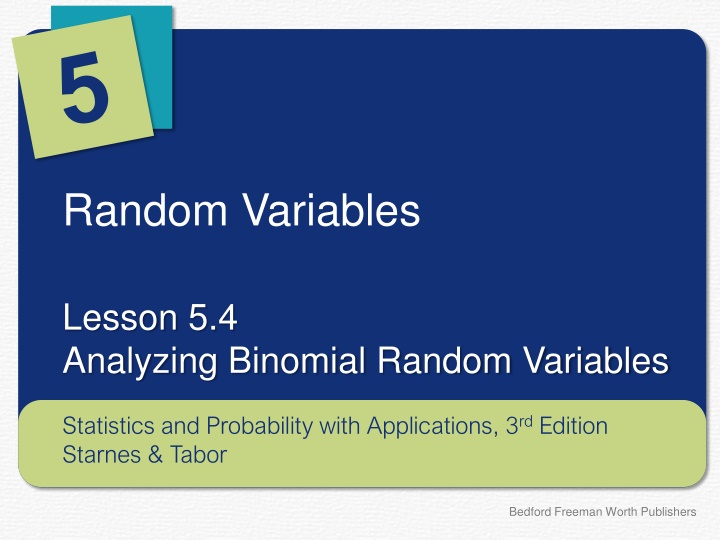
Understanding Binomial Random Variables in Genetics
Learn how to analyze binomial random variables in genetics, specifically focusing on the probability of children inheriting type O blood from their parents and calculating mean and standard deviation. Understand the application of binomial distributions in genetics.
Download Presentation

Please find below an Image/Link to download the presentation.
The content on the website is provided AS IS for your information and personal use only. It may not be sold, licensed, or shared on other websites without obtaining consent from the author. If you encounter any issues during the download, it is possible that the publisher has removed the file from their server.
You are allowed to download the files provided on this website for personal or commercial use, subject to the condition that they are used lawfully. All files are the property of their respective owners.
The content on the website is provided AS IS for your information and personal use only. It may not be sold, licensed, or shared on other websites without obtaining consent from the author.
E N D
Presentation Transcript
Random Variables Lesson 5.4 Analyzing Binomial Random Variables Statistics and Probability with Applications, 3rdEdition Starnes & Tabor Bedford Freeman Worth Publishers
Analyzing Binomial Random Variables Learning Targets After this lesson, you should be able to: Calculate and interpret the mean and standard deviation of a binomial distribution. Find probabilities involving several values of a binomial random variable. Use technology to calculate cumulative binomial probabilities. Statistics and Probability with Applications, 3rdEdition 2 2
Analyzing Binomial Random Variables To calculate the mean of a discrete random variable X, we use the formula X= E(X) = x1p1+ x2p2+ x3p3+ ... Calculating the Mean of a Binomial Random Variable If a count X of successes has a binomial distribution with number of trials n and probability of success p, the mean of X is X = np Statistics and Probability with Applications, 3rdEdition 3 3
Analyzing Binomial Random Variables To calculate the standard deviation of a discrete random variable X, we use the formula Calculating the Standard Deviation of a Binomial Random Variable If a count X of successes has a binomial distribution with number of trials n and probability of success p, the standard deviation of X is Caution! Remember that these formulas for the mean and standard deviation work only for binomial distributions. Statistics and Probability with Applications, 3rd Edition 4 4
Analyzing Binomial Random Variables According to the science of genetics, the genes children receive from their parents are independent from one child to another. Each child of a particular set of parents has probability 0.25 of having type O blood. Suppose these parents have 5 children. Let X = the number of children with type O blood. xi pi 0 1 2 3 4 5 0.2373 0.3955 0.2637 0.0879 0.0147 0.00098 Mean: Based on our formula for the mean: mX= np = 5(.25) =1.25 Standard Deviation: Based on our formula for the standard deviation sX= np(1- p) = 5(.25)(.75) =0.968 Statistics and Probability with Applications, 3rd Edition 5 5
Analyzing Binomial Random Variables According to the science of genetics, the genes children receive from their parents are independent from one child to another. Each child of a particular set of parents has probability 0.25 of having type O blood. Suppose these parents have 5 children. Let X = the number of children with type O blood. xi pi 0 1 2 3 4 5 0.2373 0.3955 0.2637 0.0879 0.0147 0.00098 What s the probability that at most 1 of the children has type O blood? In symbols, it s P(X 1). We can compute this cumulative binomial probability using the fact that P(X 1) = P(X=0) + P(X=1) = 0.23730 + 0.39551 = 0.63281 What if we want to find the probability that at least 2 of the couple s 5 children have type O blood? In symbols, that s P(X 2). We could compute this probability using the fact that P(X 2) = P(X=2) + P(X=3) + P(X=4) + P(X=5) = 0.26367 + 0.08789 + 0.01465 + 0.00098 = 0.36719 Statistics and Probability with Applications, 3rd Edition 6 6
LESSON APP 5.4 Free lunch? A local fast-food restaurant is running a Draw a three, get it free lunch promotion. After each customer orders, a touch-screen display shows the message, Press here to win a free lunch. A computer program then simulates one card being drawn at random from a standard deck of playing cards. If the chosen card is a 3, the customer s order is free. (Note that the probability of drawing a 3 from a standard deck of playing cards is 4/52.) Otherwise, the customer must pay the bill. Suppose that 250 customers place lunch orders on the first day of the promotion. Let X = the number of people who win a free lunch. Statistics and Probability with Applications, 3rd Edition 7 7
LESSON APP 5.4 Free lunch? 1. 2. 3. 4. Explain why X is a binomial random variable. Find the mean of X. Interpret this value in context. Find the standard deviation of X. Interpret this value in context. One of the customers is surprised when only 10 people win a free lunch. Should the customer be surprised? Find the probability that 10 or fewer people win a free lunch by chance alone and use this result to support your answer. Statistics and Probability with Applications, 3rd Edition 8 8
Analyzing Binomial Random Variables Learning Targets After this lesson, you should be able to: Calculate and interpret the mean and standard deviation of a binomial distribution. Find probabilities involving several values of a binomial random variable. Use technology to calculate cumulative binomial probabilities. Statistics and Probability with Applications, 3rd Edition 9 9
